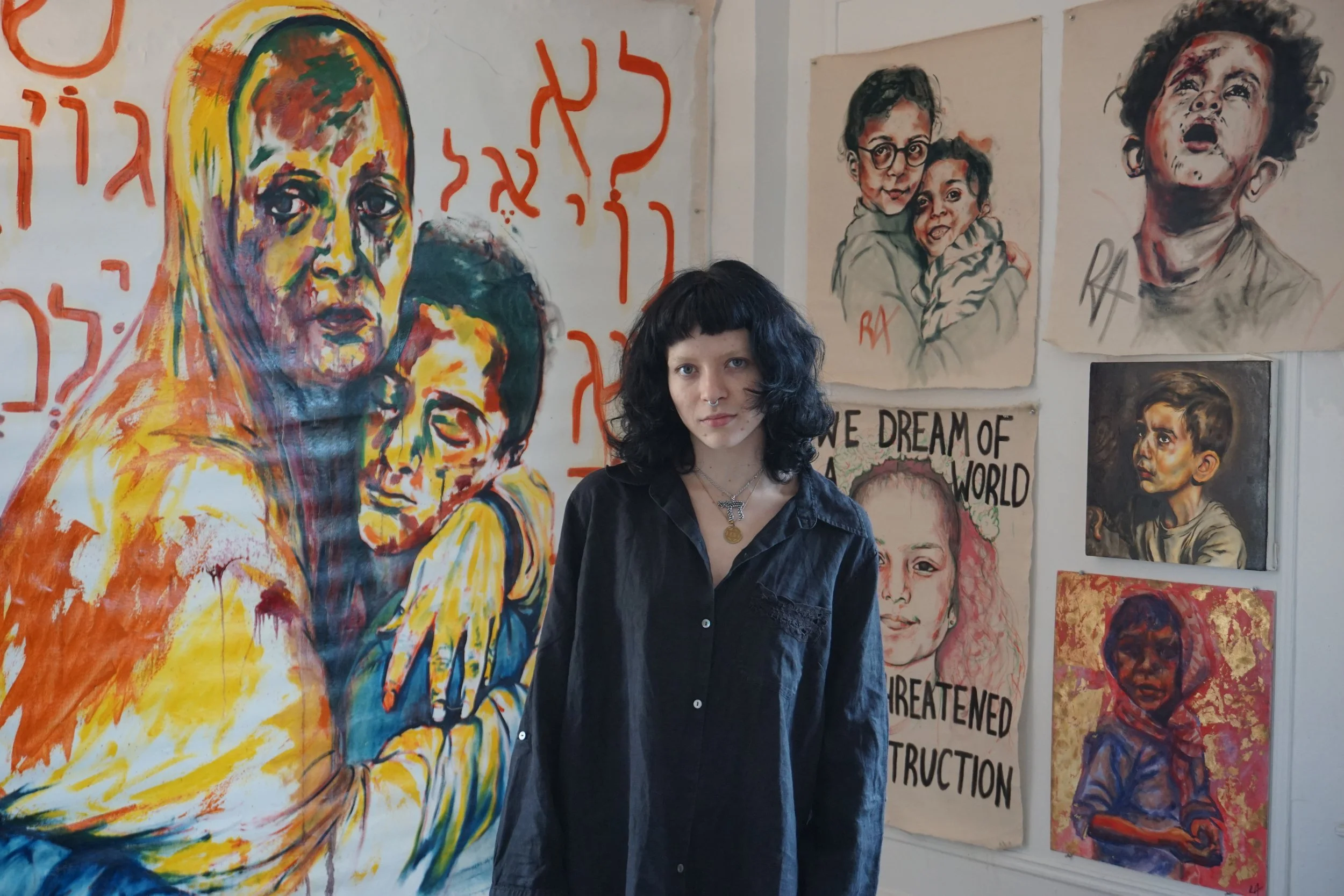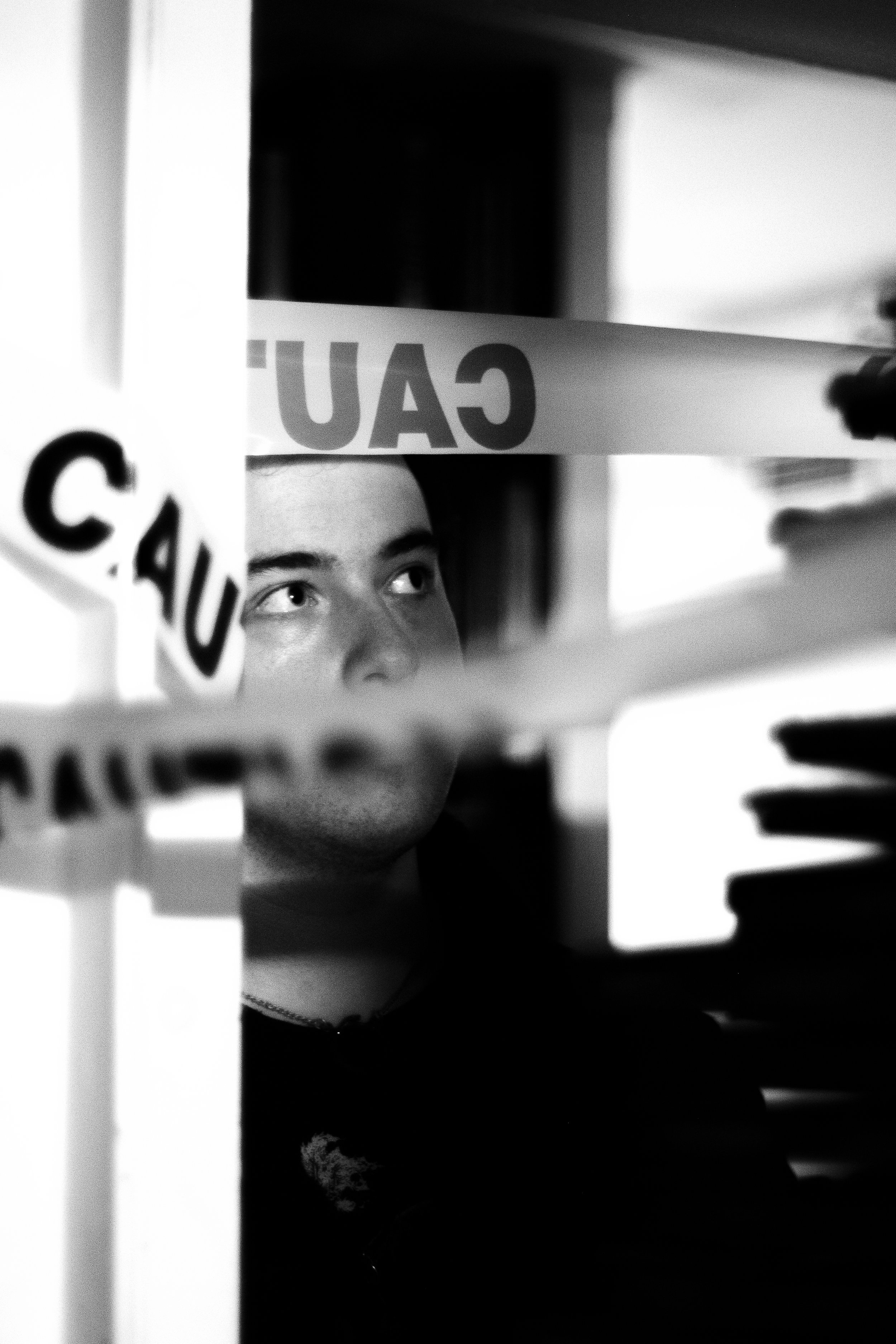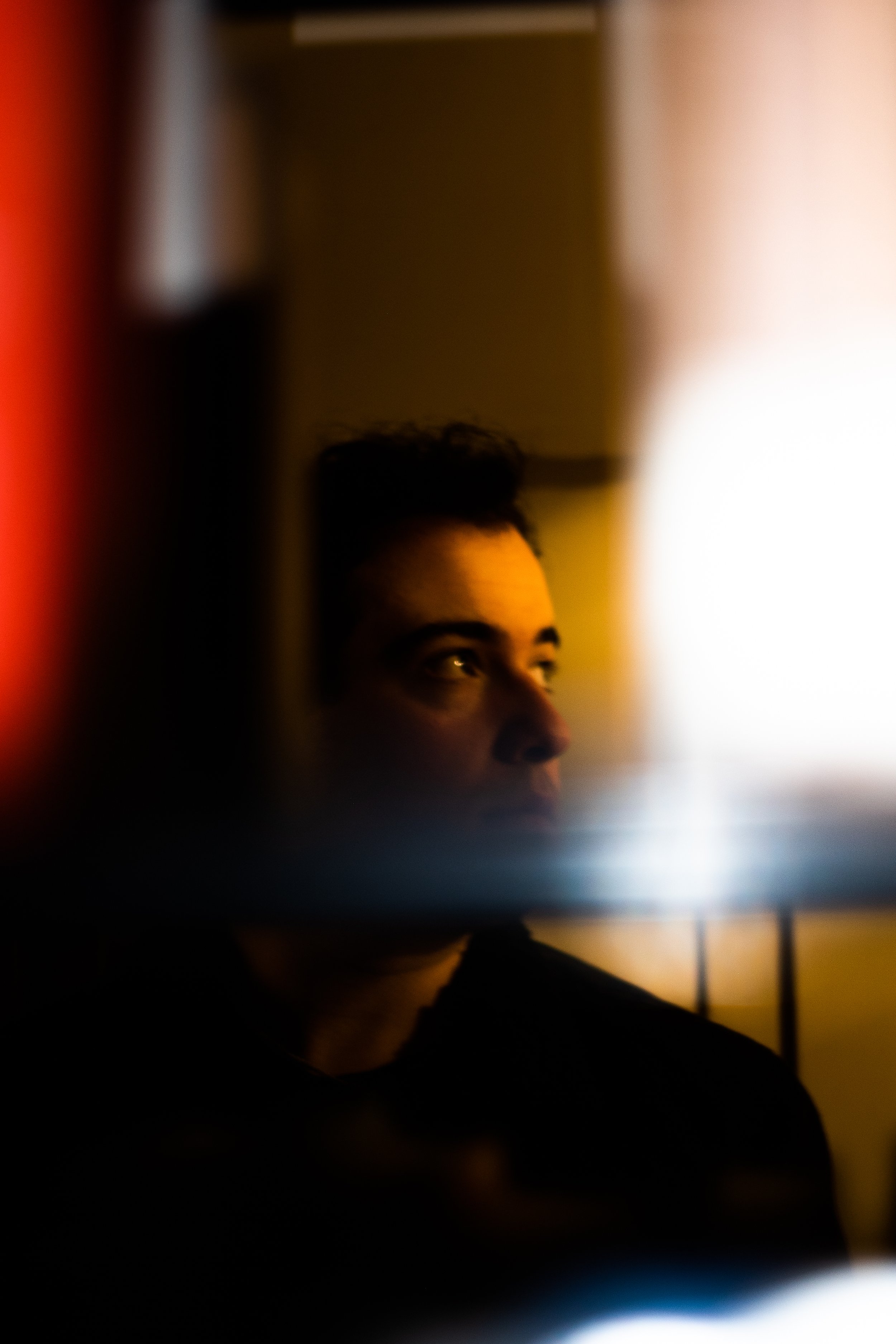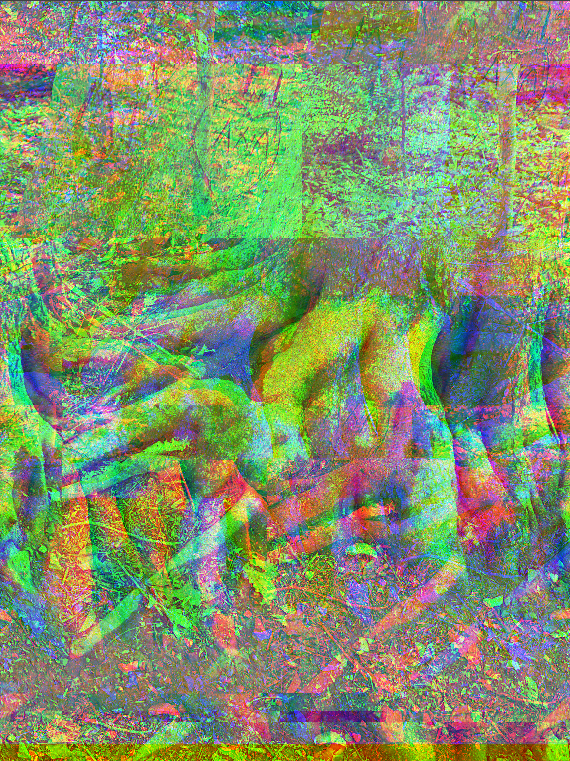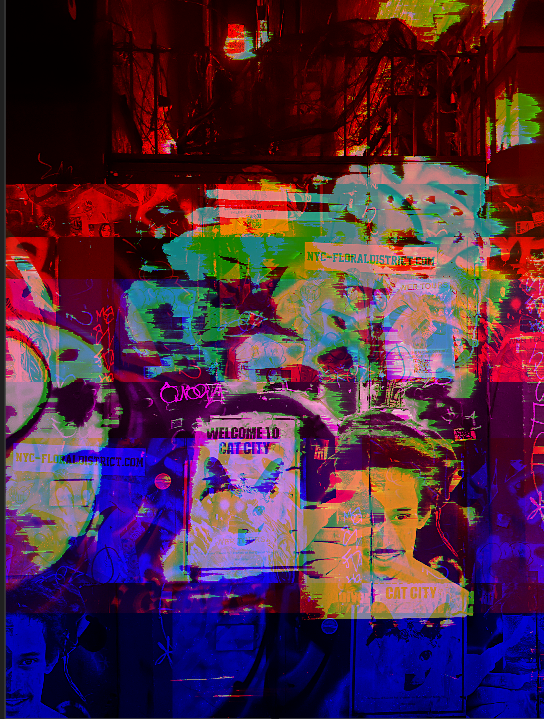Feature by Nathan Ko
Photos by Adela Schwartz
Jamie Iacovitti is a junior at Columbia College majoring in English with a concentration in East Asian Language and Culture. Jamie’s particularly interested in photography and databending. He also sometimes indulges in writing short stories. His work challenges the audience to acknowledge the existence of different perceptions of the world—perceptions perhaps more radical and colorful than ours.
My first interaction with Jamie was over email. I got an enthusiastic email from him asking for a time to meet. He generously gave me a list of times that stretched from Monday to Sunday.
At that time, I was bombarded with work. I received a follow-up e-mail from Jamie which I tend to find quite scary. It’s not that they’re rude, but rather I just feel bad that I didn’t get to their e-mail on time. And I felt similarly in this situation. Jamie’s follow-up email, however, wasn’t scary at all. The smiley faces and soothing tone of his email reassured me that Jamie was the type of guy who I would love to talk to.
I first met Jamie in person on the first floor of Shapiro Hall before going to his dorm where we later conducted the interview. We quickly said hi, and I couldn’t help but notice that his loud t-shirt, stained with neon colors, felt reminiscent of his vibrant art. He had effortlessly messy hair that any artist in New York would envy. We head to his room, and I, again, find myself immersed in colors. His room had LED lights running through his walls as many Columbia students have. He also had his own art with its flashes of neon colors, which many Columbia students don’t have. This rush of colors and sensations is something that appears throughout his photos that use databending. Databending is the process of manually corrupting the metadata and code of digital pictures. The result is a sort of unsettling, neon photograph that feels both familiar yet foreign.
I mentioned this sort of rush, and he brought up his own sensory issues.
“I get overwhelmed very easily by certain things. Databending gives me a way to make an audience feel the way I feel, an onrush of sensations they may not feel on a daily basis.”
This feeling of rush is something that also stems from Jamie’s interest in horror. He mentions how one of his favorite games, Silent Hill, is a horror game, and talks about how the genre of horror carries over to his work.
“I think there might be a touch of cosmic primal horror in my work, but it's not explicitly expressed.”
When we think about horror, we often think of being spooked at a haunted house or looking at something really creepy. Yet, for Jamie, horror is more associated with the feeling of engulfment.
“It's more about primal nature, something that unnerves you without being outright scary. Overstimulation plays into that feeling, something you can experience in various aspects of life.”
Jamie’s interest in horror overall stemmed from the release of Coraline, a movie that spooked him as a young kid. He was scared to the point of always keeping the lights on. But, years later, he decided to confront his fear head-on by watching Coraline again, and this time, he was really intrigued by it. Specifically, when watching Coraline, he felt a primal feeling—a type of fear that can be felt deeply on an instinctual level.
It’s not just Coraline that inspired him as an artist. By watching a lot of movies as a kid, Jamie would see these beautiful shots and decide that he could replicate such beauty through photography. As a kid, he would use his Nintendo DSI as his camera. And, later on, he found a video of someone databending, and it reminded him of the y2k aesthetic that he was interested in. After being mesmerized by the process, he reached out to the content creator on how to databend. Surprisingly, the content creator responded to Jamie and gave him a rundown. Ever since that moment, Jamie has been databending.
For Jamie, databending is an interesting tool because it allows him to accomplish a lot of things: he’s able to challenge the audience’s own perceptions of the world by offering a new perception, a manipulated vision that’s eerie—unstable, almost.
“Everyone has a different perception of the world. The way I see the world is different than how you see the world. This carries over to databending when you’re able to make pictures that look completely different from their original form but still technically the same subject.”
This idea of destroying our own conceptions of the world is something quite overt in Jamie’s work. In Jamie’s piece “cuore,” which has the words “DESTROY THE WORLD” all in capital, he mentions how he aimed to destroy our own perceived ideas of the world through databending. Essentially, Jamie’s trying to show a radical reimagining of a photo of reality to prove the existence of different views of the world.
Cuore
This idea was not something Jamie thought of overnight but rather came through watching anime. One of his main inspirations in art is the anime Serial Experiments Lain which comments on the instability of the way we view the world. That certainly carries over to his idea of destroying our own perceptions of reality. He’s also inspired by Neon Genesis Evangelion. That anime, for Jamie, explored the idea of how others view us differently from how we view ourselves, which enticed him.
This repeating theme of the instability of our perceptions isn’t something only unique to Jamie’s visual artworks. Jamie’s an English major, and he often explores the theme of perception through creative writing.
“A lot of things I write are about perspective or about the internal flawed thinking. Most of the things I write about are people learning that what they're perceiving is just not accurate. A lot of things I write, like the perspectives and points of view, are all jumbled up and messed up, and you have to kind of figure out what’s happening. In the same way, when you look at a picture of mine, you’re asking yourself what the original subject may be.”
In that way, writing and photography have overlaps in Jamie’s interests. However, in creative processes, they’re quite different. While Jamie describes writing to be all his effort, he says that photography that involves databending is different.
In a way, databending is somewhat of a blind process. During the process of databending, Jamie’s unable to see what he’s really doing to the pictures. He’s just corrupting the metadata and code; hence, the visuals are determined by random chance. He mentions how this allows some sort of higher power to offer their finishing touches on his photos.
While Jamie’s not strictly religious, he mentions that his Catholic childhood makes him more of a spiritual person. He describes how that carries over to his art.
“In Catholicism, there's this feeling of God's presence all around. I think there's some truth to that, as there's an external force moving the universe. Databending allows that force to take over. You can't physically see the changes you make to the picture. It's like pressing random buttons and letting chaos or whatever force you believe in, interact with the photo. If the outcome is appealing, great. If not, you restart and let the universe work its magic. I'd say it's about 50% me and 50% the universe. I take the initial picture and then let the universe take the reins after pressing those random buttons.”
In the process of pressing those buttons to digitally manipulate his photos, Jamie’s actively exploring a contradiction. Jamie mentions how his work explores the chaos that emerges from the binary of the concrete and the digital—the photographs of the world he takes and the digital databending of them. He’s particularly interested in this binary even though it may seem contradictory at times.
“The universe works in contradiction, so having a more physical medium like photography and converting it digitally and making the digital part of it a big part of the process is just something I find very beautiful.”
Jamie’s emphasis on contradiction reminded me of the way John Keats described Shakespeare—the way in which he possessed “negative capability.” And by negative capability, Keats means the ability of an artist to explore contradictions and uncertainties without reaching a clear conclusion. It seemed like Jamie was not bugged by and perhaps rather comfortable with this murky, contradictory space. The contradictory space of taking his own photos of the world and having the universe manipulate them.
But, in a way, his comfortability with digitally manipulating his photos makes sense given his STEM background. Jamie used to be a student in the engineering school before he transferred to Columbia College and became an English major. Hence, he finds the digital process to be a comfortable medium to explore his art.
When Jamie brought this up, I was shocked, since there are very few students I know who transfer from one undergraduate college to another at Columbia, and the shift from STEM to English felt very abrupt for me. Jamie mentioned how he had a severe car accident in 2021 that shifted the way he viewed life. In a way, it was a memento mori incident, a moment that reminded him of the inevitability of death.
“I thought, ‘I'd rather die happy than be depressed.’ It shifted my perspective and made me realize I don't have to conform to a life that doesn't bring me joy. It allowed me to choose to live a happy life, and that was the most significant change to stem from the accident.”
Such an accident not only propelled him to study English but also fueled him to start making art.
“Perhaps a little while after the car accident, I felt the urge to pursue art further, something I always wanted to do but lacked the determination until then.”
As he quickly decided to do art, he started to make art without any training.
“It's all self-taught. I haven't received any formal art training, not even in writing. My writing 'training' was in English class.” He mentions that trial and error and learning through the love of the craft is what allowed him to produce art on a higher level.
During the interview, I remember being impressed by Jamie’s self-urgency to create art, especially without training. I noted how it must have taken a lot of self-confidence, and Jamie mentioned how he used to be an anxious kid without any self-esteem. He brought up how his friend Soph from Cincinnati, Ohio was someone who brought out his confidence, which allowed him to pursue art.
And with this confidence, Jamie’s able to perhaps explore more art forms as well. While Jamie doesn’t have any set plans for the future, he did tell me that he has a budding interest in pursuing music, which just like photography and writing, he’s willing to learn by himself.
“Art has visual, written, and musical aspects. Music seems like the third major one. Maybe I can call myself an artist within these realms.”
The process of being self-taught is something that impacted all his artistic processes. Hence, in a way, Jamie feels that making art for him almost depends on being self-taught.
Teaching myself makes the process of making art more personal. And I think because I was self-taught, I take the pictures that I take and write the stories that I write. It’s a very internal process of learning and the style of art that comes out of it becomes more personal.”
To find more of Jamie’s art, you can access his Instagram.

